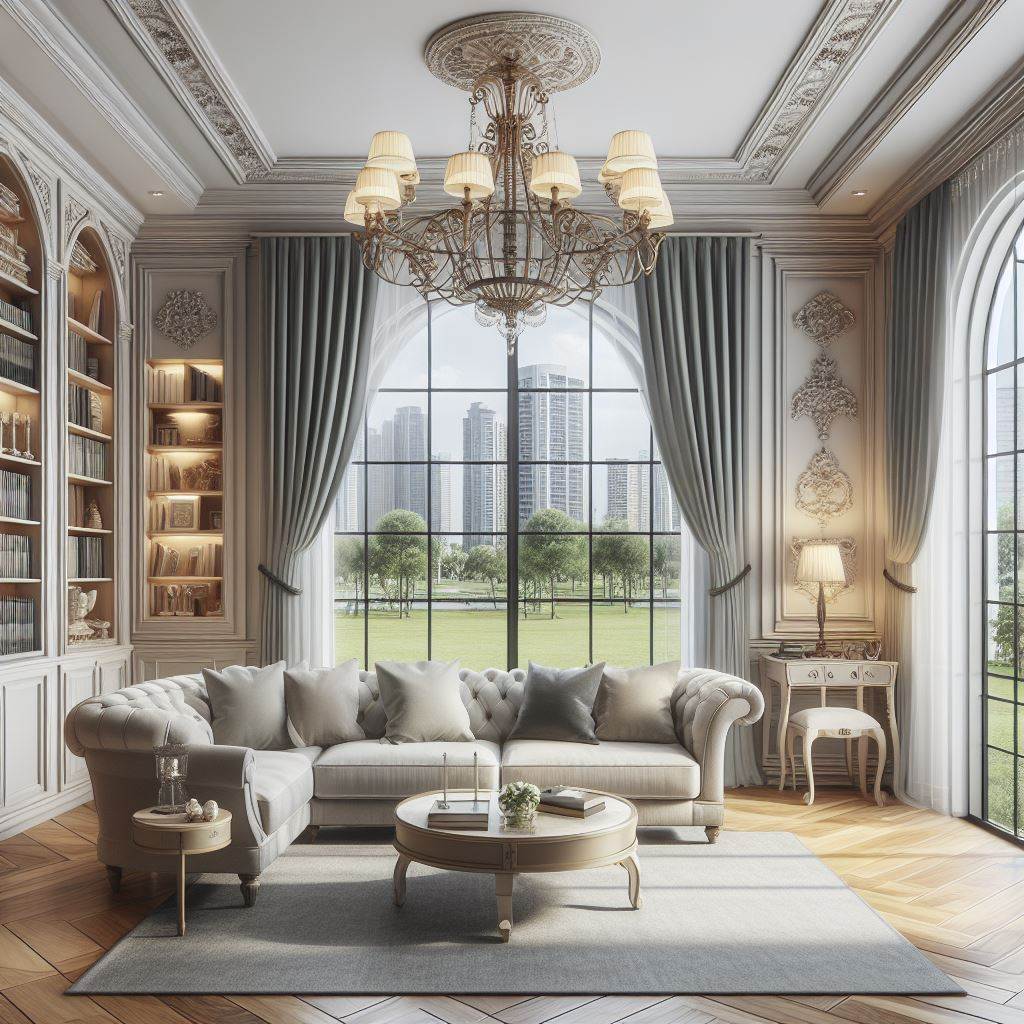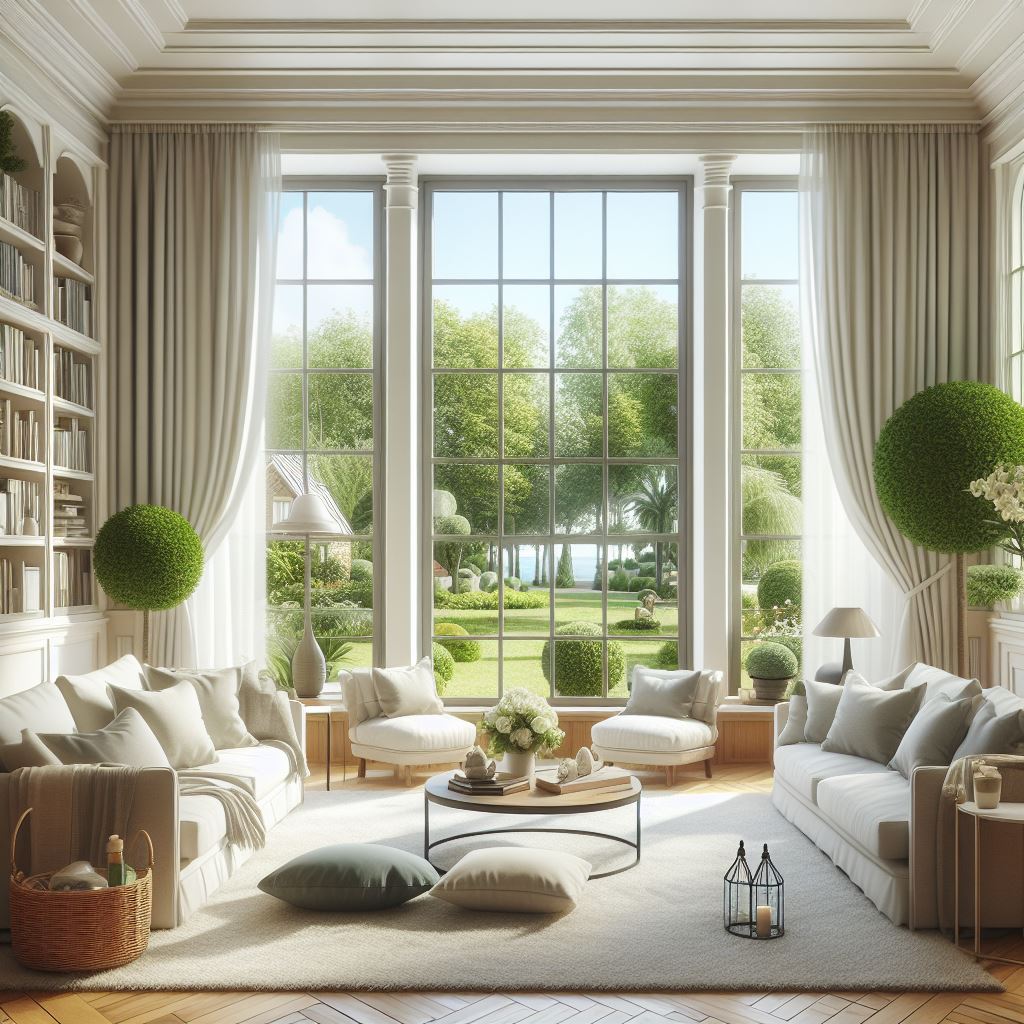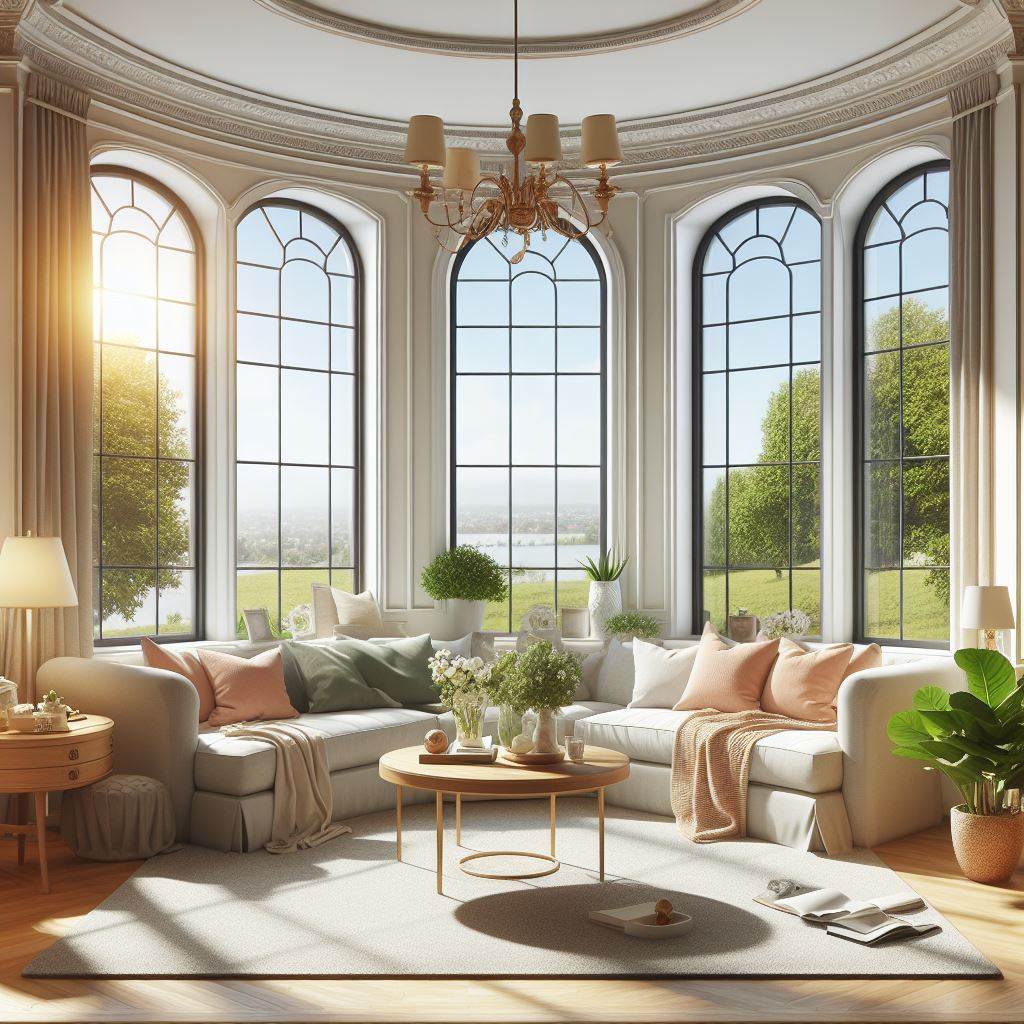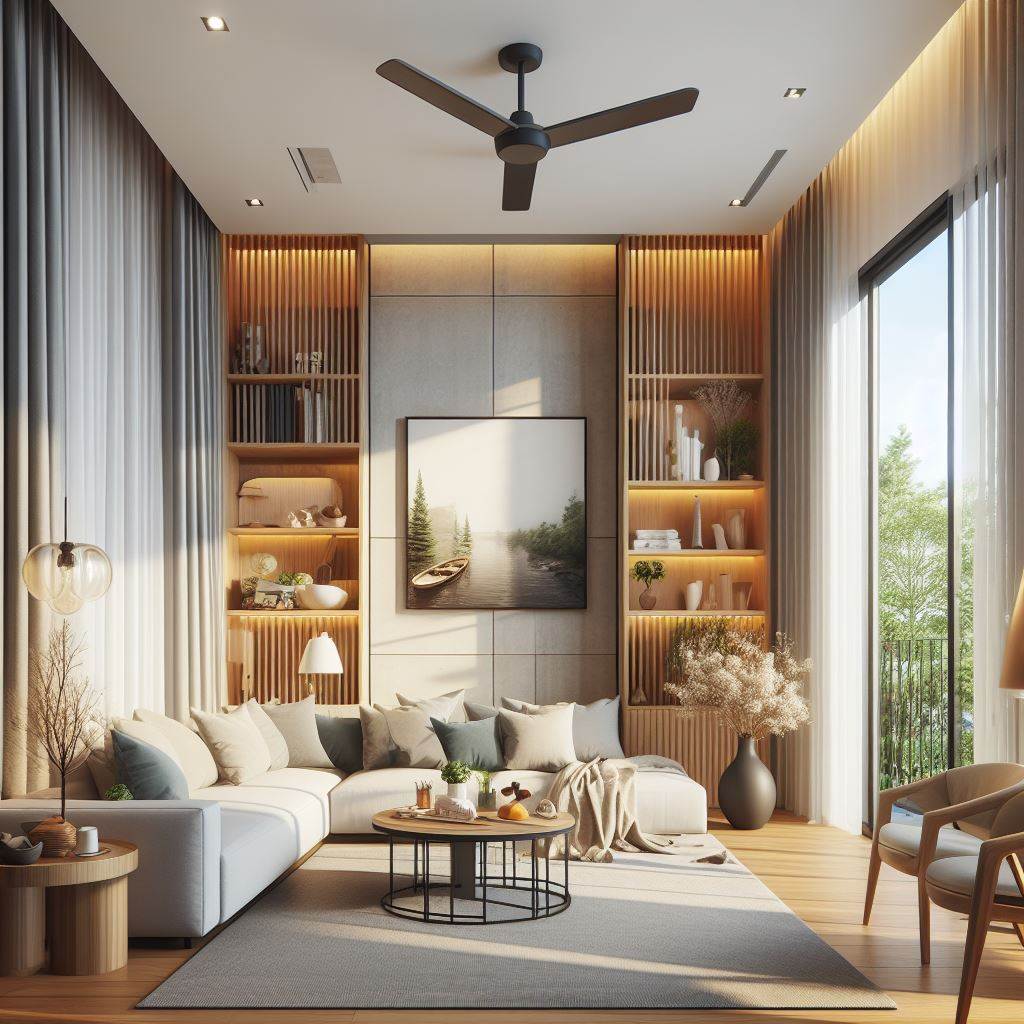The living room is a sanctuary for relaxation, entertainment, and connection. But what if the world outside feels distant, unable to truly seep into your haven? The culprit might be your windows, the silent gatekeepers of light, ventilation, and visual connection to the outdoors. The right window style can completely transform your living space, bathing it in natural light, whispering fresh air, and framing breathtaking views or charming streetscapes. This guide highlights 7 of the most popular window styles that can elevate your living room to new heights.
7 Window Styles to Brighten Your Living Room
Choosing the perfect window style for your living room goes beyond aesthetics. It’s a symphony of functionality, light control, ventilation needs, and architectural harmony. Here’s a closer look at seven window styles, each offering unique advantages:
1. Double-Hung Windows: Timeless Elegance and Ventilation Control

Double-hung windows are the quintessential choice, featuring two vertically sliding sashes. Both the upper and lower sashes can be independently opened, offering exceptional control over ventilation. This classic style seamlessly complements various architectural styles, from traditional to contemporary. Cleaning is a breeze with double-hung windows, as the sashes can tilt inwards for easy access to the exterior glass.
However, it’s important to consider that fully opened sashes might project inwards, potentially blocking wall space for furniture placement.
· Pros:
- Timeless design that complements various architectural styles, from colonial to contemporary.
- Excellent ventilation control as both sashes can be opened.
- Easy to clean due to accessible sashes.
· Cons:
- Might block wall space when both sashes are fully opened.
- May not offer the most expansive views compared to other styles.
2. Casement Windows: Unobstructed Views and Modern Appeal

Casement windows boast a sleek and modern aesthetic. They operate by hinging at the side and opening outwards like a door. This design provides exceptional, unobstructed views of the outdoors, making them ideal for scenic vistas. Casement windows also excel at capturing refreshing breezes, perfect for creating a naturally ventilated living space.
While undeniably beautiful, casement windows might not be the most suitable option for areas with limited opening clearance due to nearby walls, furniture, or landscaping.
· Pros:
- Unobstructed views due to the single pane design.
- Excellent for capturing refreshing breezes.
- Modern and stylish look that complements contemporary homes.
· Cons:
- May not be suitable for areas with limited clearance for opening outward.
- Requires proper installation to ensure smooth operation and weatherproofing.
3. Bay and Bow Windows: A Focal Point with Panoramic Charm

Craving a dramatic focal point in your living room? Look no further than bay and bow windows. Bay windows feature three or more angled windows projecting outwards, creating a delightful nook. Bow windows, on the other hand, achieve a similar effect with a curved design.
Both styles offer breathtaking panoramic views and increased natural light, transforming your living space into a sun-drenched haven. Additionally, the projecting windows create a charming alcove perfect for a cozy reading nook or a bright seating area.
However, these beauties require more installation complexity and might not be suitable for smaller living rooms due to their space requirements.
· Pros:
- Create a beautiful focal point in the living room, adding architectural interest.
- Offer expansive views and increased natural light for a brighter and more spacious feel.
- Provide additional space for seating or a cozy reading nook.
· Cons:
- Require more space for installation compared to standard windows.
- Installation can be more complex compared to single-unit windows.
4. Picture Windows: Frame the World in Grand Style

Picture windows are for those who want to truly immerse themselves in the wonders of the outdoors. These large, fixed panes offer unobstructed views, creating a seamless connection between your living room and the outside world. Picture windows make your living space feel more expansive and bring in an abundance of natural light, fostering a connection with nature.
The downside? Picture windows don’t open, limiting ventilation options. Consider pairing them with other window styles like casement windows to ensure proper air circulation.
· Pros:
- Showcase stunning outdoor scenery, blurring the lines between indoors and outdoors.
- Create a feeling of spaciousness by maximizing the visible area.
- Allow for maximum natural light, brightening up the living room.
· Cons:
- Limited ventilation as the window cannot be opened.
- May not be ideal for all climates, especially those with extreme temperatures.
5. Sliding Windows: Space-Saving Simplicity

Sliding windows are a popular choice for their space-saving design. They feature horizontal sashes that slide open sideways, offering a clean and contemporary look. Easy to operate, these windows provide good ventilation and are ideal for areas with limited wall space since they don’t project inwards when opened.
However, compared to double-hung windows, the opening area of sliding windows might be slightly smaller, potentially impacting the amount of ventilation they provide.
· Pros:
- Efficient use of space, perfect for smaller living rooms.
- Easy to operate, making them ideal for high or hard-to-reach areas.
- Offer good ventilation when opened.
· Cons:
- Less ventilation area compared to double-hung windows as only half the window opens at once.
- May not provide the most aesthetically pleasing view with the central rail dividing the window.
6. Awning Windows: A Breath of Fresh Air, Rain or Shine

Awning windows are hinged at the top and open outwards, resembling a small awning. This unique design allows for ventilation even during rain, as the angled sash deflects rainwater away from the opening. Perfect for basements, attics, or areas with limited overhead space, awning windows offer good ventilation control and a touch of modern flair.
· Pros:
- Ideal for capturing breezes and allowing ventilation during rain.
- Well-suited for basements or areas with limited overhead space for opening.
- Provide good ventilation control when adjusted to the desired angle.
· Cons:
- May not offer expansive views due to the angled opening.
- Cleaning the exterior of the window can be more challenging.
7. Corner Windows: Panoramic Vistas and a Design Statement

Corner windows create a stunning 90-degree view, offering breathtaking panoramas of the surrounding landscape. They bathe your living room in natural light from two directions, creating a truly expansive and inviting atmosphere. Corner windows are a bold design statement, adding a touch of architectural interest to your living space.
It’s important to note that due to the larger opening and unique structure, corner windows might require additional structural support during installation.
· Pros:
- Breathtaking panoramic views, perfect for enjoying scenic landscapes.
- Maximize natural light intake, creating a bright and airy living space.
- Unique design element that adds a touch of modern sophistication.
· Cons:
- Might require additional structural support due to the larger opening.
- May be more expensive compared to standard window styles.
Choosing the Perfect Living Room Window
Now that you’ve explored the unique characteristics of these seven window styles, it’s time to find the perfect match for your living room. Here are some key factors to consider:
- Ventilation Needs: Do you prioritize maximum airflow for hot climates, or is occasional ventilation sufficient? Double-hung and casement windows offer excellent ventilation, while picture windows require pairing with another style for air circulation.
- View and Natural Light: Are you blessed with a breathtaking vista or a charming streetscape? Maximize your view with picture, corner, or bay/bow windows. For ample natural light, prioritize large fixed panes or operable windows like double-hung or casements.
- Architectural Style: Double-hung windows complement traditional and contemporary styles. Casement and sliding windows lean modern, while bay/bows add a touch of classic charm. Corner windows can be a bold statement in modern or contemporary settings.
- Space Considerations: Sliding windows are ideal for space-saving, while bay/bows and corner windows require ample space.
- Privacy Concerns: If privacy is a concern, consider blinds, shades, or frosted glass inserts for specific windows.
- Budget: Window styles and materials vary in cost. Double-hung and casement windows are generally more affordable than bay/bows or corner windows.
Consulting a Window Specialist
Choosing the right window style can be overwhelming. However, window specialists are there to guide you through the process. They can assess your living space, discuss your needs and preferences, and recommend the most suitable window styles for your home. They can also provide information on energy efficiency ratings, materials, and installation considerations.
Here are some questions to ask your window specialist:
- Which window styles would best suit my ventilation needs and desired level of natural light?
- What materials are best suited for my climate and budget?
- Are there any energy-efficient options available for my chosen style?
- What additional features, such as grilles or frosted glass, can be incorporated?
- Can you provide an estimate for installation costs?
By working with a window specialist, you can ensure that your living room windows not only enhance aesthetics but also function optimally for your needs.
Beyond the Window: The Finishing Touches
Once you’ve chosen the perfect window styles, consider the finishing touches to truly elevate your living space. Here are some ideas:
- Window Treatments: Curtains, blinds, or shades can add a pop of color, texture, and privacy. Choose light-filtering options if you want to maximize natural light.
- Window Seating: Utilize the space beneath bay/bow windows with built-in seating and plush cushions, creating a cozy reading nook or conversation area.
- Plants and Greenery: Bring the outdoors in by placing strategically positioned plants near windows.
- Furniture Arrangement: Arrange furniture to take advantage of the natural light and views offered by your windows.
Wrapping Up
The right window style can transform your living room from a simple space into a light-filled haven that fosters connection with the outdoors. Just be sure to consider your ventilation needs, desired level of natural light, architectural style, and personal preferences to choose the perfect window to elevate your living space. Remember, a window specialist can be a valuable resource, guiding you towards the ideal solution for your unique needs. So, don’t hesitate to seek their expertise and unlock the full potential of your living room windows.
Now go ahead and embrace the light, embrace the views, and create a living room that truly reflects your style and connects you to the world outside! We’d also love to hear from you! Share your favorite window styles and how they’ve transformed your living space in the comments section below. What tips or tricks do you have for maximizing the impact of windows in a living room? Let’s create a conversation around the magic of windows!

